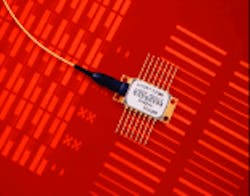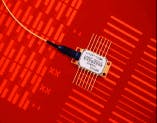Demand triggers advances in dense WDM components
Demand triggers advances in dense WDM components
New fiber, amplifiers, and sources will be needed to meet the high-speed, broadband requirements of future optical networks.
Raymond Nering
Driven by the growth of Internet access and appetite for high-speed data and high-capacity video, the need for a high-capacity long-haul backbone and high-speed local access continues to accelerate. Fortunately, dense wavelength-division multiplexing (DWDM) lightwave-transmission systems can provide fiber networks with a very-high-capacity (40 to 1000 Gbit/s) range.
Initially, wavelength-division multiplexing (WDM) meant increasing capacity of any single-fiber line from one to two wavelengths, without making major technological changes. Obvious advantages of this quick-fix capability included the ability to upgrade existing fiber lines easily and to dramatically increase capacity, virtually overnight. But now, just a few years after the introduction of DWDM, this demand for higher channel densities and data rates is exerting tremendous pressure on underlying components such as fiber, amplifiers, and sources.
Critical technology challenges
A critical factor in providing DWDM systems is delivering the necessary components in large volume. In DWDM, it is the components that determine capabilities. One year ago, transmitting 20 Gbit/s worth of data from point A to point B with two 10-Gbit signals running at 10 Gbits would have required a regenerator every 80 to 100 km. Today, sending at 2.5 Gbit/s with eight OC-48 signals, the same speed and clarity are accomplished--without any regeneration--over more than 600 km.
Components, especially amplifiers, are already pushed beyond signal design capabilities. Generally, systems are being designed for the wavelength range from 1530 to 1560 nm because erbium-doped fiber amplifiers (EDFAs) operate relatively efficiently in this range. But this design does not take advantage of the entire range of the low-loss window of the fiber, which is about ten times wider. Some work is being done above 1560 nm, which will push the state of the art of commercial EDFA design well beyond where it is today. This development will also require new sources in this range. The next hurdle will be at 1600 nm, where the responsivity of the detectors drops off dramatically. Some companies are looking to commercialize systems with a wavelength range up to 1600 nm.
For short-distance systems, amplifiers may not necessarily be needed. High-power lasers can overcome the losses of these systems and extend the overall distance that can be covered. Short-haul systems generally cover distances of less than 75 km. They do not use EDFAs, thus are not constrained by their bandwidth limitations (see photo).
Need for dispersion compensation
As distances lengthen and higher data rates are targeted, requirements change again. At higher data rates--10 Gbit/s, for example--there is substantial sensitivity to the dispersion characteristics of the fiber. Using today`s components, 10-Gbit/s applications are typically limited to 80-100 km, where regeneration of the signal is required. For signals to travel several hundred kilometers, dispersion compensation is necessary. One possible solution is to use dispersion-compensating fiber (DCF).
Dispersion-compensating fiber has dispersion opposite to that of standard fiber. Lengths of this fiber can be introduced into the system to null out the dispersion of transmission fiber. Unfortunately, DCF introduces a fair amount of loss in the system, and additional amplification is required to overcome the loss. This is often accomplished by inserting the compensating fiber between gain stages of an EDFA, although this makes the EDFA more complicated, requiring additional optical ports and isolation in the device.
Another challenge comes from using wider bands of transmission channels. As a result, the gain profile of the amplifier must be better controlled. Typically, this gain is not very flat. When traveling through as many amplifiers as would be necessary in a 600-km system--in which amplifiers are placed every 80 km--any tilt to the gain, or difference in gain access across the bands, will start to multiply through each amplifier. If the gain is not flat, but has a peak in one part of a spectrum, that gain peak will dominate the system, causing a strong channel near the peak. Channels in other areas of the band will be weak, and signals will always be degraded, creating problems with those channels.
Ideally, it would be nice to have a flat gain across the optical bandwidth of the amplifier. However, a flat gain requires a lot of power. The solution is to put a compensating filter in the amplifier that attenuates where there is a lot of gain and does not attenuate where there is no gain. More power is placed in the amplifier to burn the peak gain to make up for the low gain and provide a relatively flat response.
Ultimately, with all of the tweaking of the amplifiers, the question is whether DWDM is really worth it if amplifiers are substantially more complicated and more expensive. The deciding factor is the increase in the number of channels achieved. An amplifier that costs twice as much but offers at least twice as many channels may be worth the price when considering the savings of not having to lay another fiber, especially for long-haul transmission.
Impact on design and manufacturing
Two variables are rapidly changing WDM: data rates and the number of channels. Two channels initially gave way to four and eight channels in 1994-1995, 16 in 1996, and 80 in 1998; recent announcements claim 128 channels. For a number of years, the data rate was at 2.5 Gbit/s, then two years ago, 10-Gbit/s rates were introduced. Designers now target 40 Gbit/s as soon as modulators are developed that can operate at that speed. Lucent`s upcoming WaveStar product, for example, will deliver up to 40 wavelengths at 10 Gbits--a capacity of 400 Gbit/s.
A complicating factor from a design and manufacturing standpoint is that, currently, each channel requires its own laser--a separate device for each wavelength. A 2.5-Gbit/s transmitter with 80 different channels actually requires the design and manufacture of 80 different transmitters, which is a nightmare from a manufacturing logistics standpoint. The ideal transmitting device will be tunable to any one of the wavelengths.
Amplifier designers specifically are having a difficult time working through flatness specifications. They want to cascade more EDFAs to ensure gain flatness, but then noise becomes an issue. Different schemes are in the works to deal with issues such as higher-power pump lasers for these EDFAs, combinations of pumps to put more power in the amplifier, and additional optical components--making EDFAs extremely complicated.
Although component designers working on DWDM are extremely challenged, system designers are enthusiastic. WDM systems are much more efficient--less costly per channel--and existing systems can be easily upgraded. For example, a transponder can be used to upgrade a 2.5-Gbit/s five-year-old SONET system without WDM capabilities. A transponder with a transmitter at the wavelength required directs the output of the existing SONET equipment at 1.3 µm to a receiver, then to an optical multiplexer to be split into as many wavelengths as possible. It is a fairly easy upgrade.
Manufacturing technology is a major consideration in implementing DWDM and must produce a package stable enough to allow lasers to maintain wavelength over time, environment, and the manufacturing process. This stability requires in-line characterization technologies. As channel densities increase, wavelengths need to be predicted with greater precision.
Challenges to densities and data rates
Several years ago, to achieve 10-Gbit/s capacity, it was necessary either to directly modulate a laser at 10 Gbit/s or use WDM--four 2.5-Gbit/s signals on a single fiber. It was soon recognized that WDM was easy, and electronics and lasers selected for specified wavelengths were available; all that was needed to make it work were software changes. Today, however, the focus is on much-higher densities and data rates.
A major challenge to achieving these densities and rates is the question of how tightly channels can be packed together before data rates begin to matter. The faster a laser is modulated, the broader its spectrum. If data rates increase significantly, channels cannot be packed as tightly on the fiber. Work is underway on various types of fiber to broaden the usable area of the fiber for DWDM. Lucent`s AllWave fiber extends the lower end of the band specifically for DWDM, but the fiber amplifiers needed to operate within that range are not yet available. In the meantime, the fiber can be used for short-distance applications in metropolitan-area networks.
A few years ago, a manageable 200-GHz spacing existed between channels. Today, 50-GHz spacing is a reality. Tuning devices within that range has become a real challenge, especially for electro-absorptive modulated devices. The move from 200-GHz spacing to 50-GHz spacing is actually a move from two channels to four or five. The logistics of managing increasing channel density are becoming easier, but, as channel densities go higher, wavelength stability becomes more critical.
With 200 GHz between channels, a fair amount of wavelength drift in both the laser and the multiplexer/ demultiplexer can be tolerated. Wavelength drift is attributable to ambient temperature, circuit design, and aging of devices. At 100-GHz spacing, Lucent remains confident that its device stability is adequate to be set and forgotten.
The future
Optical networking is a reality, and an all-optical network is a reasonable goal. Today DWDM provides an instantaneous burst of capacity without the expense of laying new fiber. And the number of channels certainly will not stop here. Advances in optical-network technology will dictate how the industry will grow.
Ultimately an optical network will accommodate diverse wavelengths and many channels, with certain parts of the spectrum dedicated to specific applications--allowing for the switching of wavelengths in real time to direct traffic more creatively. This creativity will require optical switches to move channels around, devices that can be tuned over a wider range to accommodate certain architectures, and a device that can instantaneously change wavelengths as data are sent out through the network. Components will route certain wavelengths around a system, and devices that can tune wavelengths quickly will become commonplace.
In the near term, optical networking will substantially reduce the cost of networks. Soon DWDM terminals will carry up to 80 wavelengths of OC-48, a total of 200 Gbit/s, or up to 40 wavelengths of OC-192, equivalent to 400 Gbit/s. o
The E2500EM-ILM laser module, featuring an integrated electro-absorptive modulator and 1.5-µm laser chip, is designed for cost- effective extended-reach high-speed (2.5 Gbit/s) data transmission.

